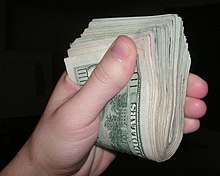Cash

In economics, cash (/kæʃ/ (![]() listen) kash,[1] or /ˈkeɪʃ/ kaysh in AuE) is money in the physical form of currency, such as banknotes and coins.
listen) kash,[1] or /ˈkeɪʃ/ kaysh in AuE) is money in the physical form of currency, such as banknotes and coins.
In bookkeeping and financial accounting, cash is current assets comprising currency or currency equivalents that can be accessed immediately or near-immediately (as in the case of money market accounts). Cash is seen either as a reserve for payments, in case of a structural or incidental negative cash flow or as a way to avoid a downturn on financial markets.
Etymology[]
The English word "cash" originally meant "money box", and later came to have a secondary meaning "money". This secondary usage became the sole meaning in the 18th century. The word "cash" derives from the Middle French caisse ("money box"), which derives from the Old Italian cassa, and ultimately from the Latin capsa ("box").[2][3].
Another origin for the word "cash" is the Portuguese word caixa, which derives from Tamil word காசு (pronounced as kācu), a small copper coin of gold or silver.[2]
History[]
| Part of a series on |
| Accounting |
|---|
 |
In Western Europe, after the fall of the Western Roman Empire, coins, silver jewelry and hacksilver (silver objects hacked into pieces) were for centuries the only form of money, until Venetian merchants started using silver bars for large transactions in the early Middle Ages. In a separate development, Venetian merchants started using paper bills, instructing their banker to make payments. Similar marked silver bars were in use in lands where the Venetian merchants had established representative offices. The Byzantine Empire and several states in the Balkan area and Kievan Rus also used marked silver bars for large payments. As the world economy developed and silver supplies increased, in particular after the colonization of South America, coins became larger and a standard coin for international payment developed from the 15th century: the Spanish and Spanish colonial coin of 8 reales. Its counterpart in gold was the Venetian ducat.
Coin types would compete for markets. By conquering foreign markets, the issuing rulers would enjoy extra income from seigniorage (the difference between the value of the coin and the value of the metal the coin was made of). Successful coin types of high nobility would be copied by lower nobility for seigniorage. Imitations were usually of a lower weight, undermining the popularity of the original. As feudal states coalesced into kingdoms, imitation of silver types abated, but gold coins, in particular, the gold ducat and the gold florin were still issued as trade coins: coins without a fixed value, going by weight. Colonial powers also sought to take away market share from Spain by issuing trade coin equivalents of silver Spanish coins, without much success.
In the early part of the 17th century, English East India Company coins were minted in England and shipped to the East. In England over time the word cash was adopted from Sanskrit कर्ष karsa,[dubious ] a weight of gold or silver but akin to the Old Persian WIKI